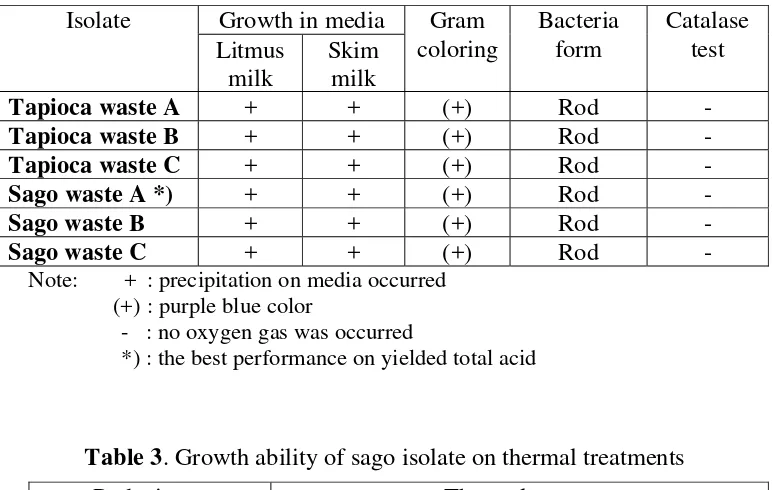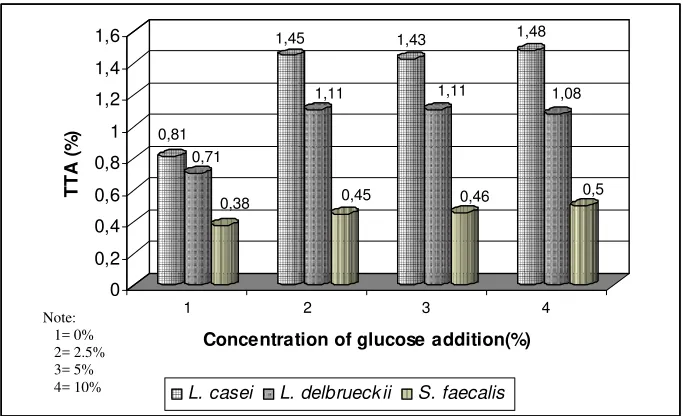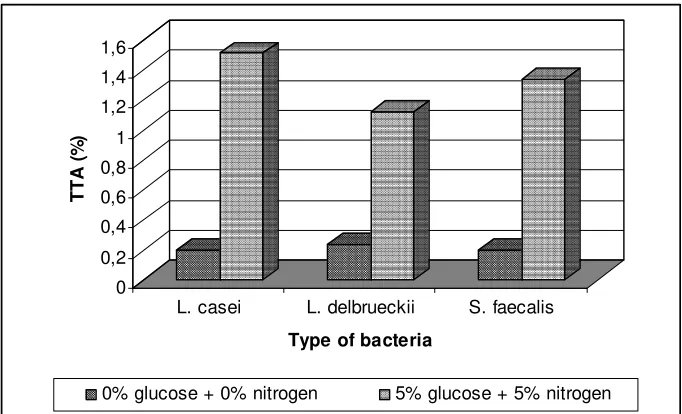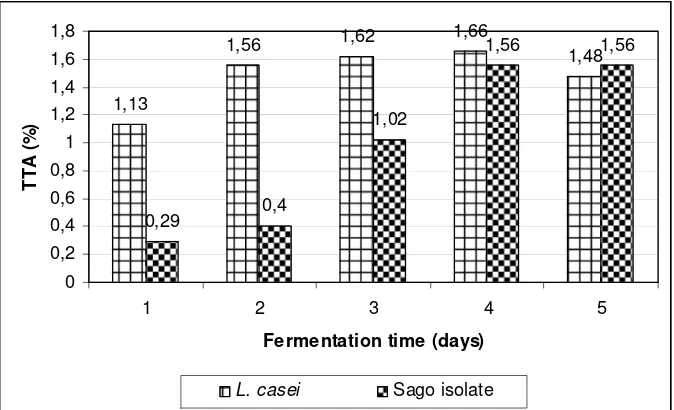LACTIC ACID PRODUCED FROM TAPIOCA AND
SAGO WASTES
Suliantari†, Yadi†, Fatim Illaningtyas†, Raffi Paramawati‡, and C. Hanny Wijaya†*
†
Department of Food Technology and Nutrition, Bogor Agricultural University
‡Indonesian Center for Agricultural Engineering Research and Development
Abstract
Liquid waste as consequences of tapioca and sago starch industries has caused environmental pollution. Mono- and disaccharides are dominant in the waste. These components are easily fermented to produce lactic acid, a potential raw material for polylactic acid (PLA). Objective of this research is to obtain the optimum fermentation condition of tapioca and sago starch industrial wastes in producing lactic acid. Liquid wastes from tapioca and sago starch industries were fermented using pure culture of Lactobacillus casei, Lb. delbruecki and Streptoccocus faecalis. Treatments of 2.5, 5 and 10% glucose addition and 5% glucose combined with 5% nitrogen were compared to none addition as a control. The effect of time fermentation was also observed. During the preliminary observation, Lb. casei exhibited more suitable as compared Lb. delbruecki and S. faecalis, hence only Lb. casei and sago isolate used at the main study. The results showed that tapioca waste produced lactic acid higher than that of sago starch waste. Treatment by adding 5% nitrogen and 5% glucose indicated the optimum condition for 4 days fermentation. At this condition, Lb. casei produce 1.98 % total acid using tapioca waste and 1.85% using sago starch waste, while culture isolated from sago waste produced 2.82% total acid using tapioca waste and 0.63% using sago starch waste.
INTRODUCTION
Cassava and sago are carbohydrate -sources that found abundantly
in Indonesia. Mostly, cassava cultivated by traditional technology and
limited inputs in upland farming area. It is found in all islands of
Indonesia as one of secondary food crops. In contrary, sago grows as
forest plants, usually found in swampy or tidal area without
cultivation. Both of them are used in manufacturing value-added food
product such as starch flour, crispy chips and snack food. The starch
flour of cassava is obtained from the tuber by series of processing:
grating, milking, condensation and separation the solid fraction. In the
same processing series, sago starch flour is obtained from the sago
trunk. The process will yield high volume of liquid waste, which
usually threw out to the drain on river. Liquid waste from starch
industry still contains carbohydrates. The liquid waste as
consequences of tapioca and sago starch industries has caused
environmental pollution, because the carbohydrate component within
the waste will be fermented by microorganism presence in the river.
The drain as well as the river will produce the putrid odor, and
increase both COD and BOD value.
Mono- and disaccharides are carbohydrates that dominant in the
waste. These components are easily fermented to produce lactic acid.
Lactic acid is widely used in food, pharmaceutical, leather, and textile
industries. Although it can be prepared by chemical synthesis,
production of lactic acid by fermentation of glucose and other
substances is a less expensive method. Recently, there has been an
increased interest in lactic acid production because it could be used as
a raw material for the production of polylactic acid (PLA). PLA is a
substitute for synthetic plastics derived from petroleum feedstock
(Datta et al, 1995 in Yun et al, 2003). Lactic acid exists as two optical
isomers, D- and L-lactic acid. Both isomeric forms can be
polymerized and polymers with different properties can be produces
depending on the composition (Hofvendahl and Hahn-Hagerdal,
2000).
Fermentative production of lactic acid is preferably made by the
group of lactic acid bacteria capable of converting hexose into lactic
acid (Sodergard and Stolt, 2002). Lactic acid bacteria are found from
the genera Lactobacillus (Lb), Lactococcus, Enterococcus,
Carnobacterium, Leuconostoc, Oenococcus, Pediococcus,
Tetragenococcus, Vagococcus, and Weissela. The carbohydrates have
been transformed via different pathways resulting in homo-, hetero-,
or mixed acid fermentation (Stiles and Holzafel, 1997 in Yun et al,
2003). However, only Lb. casei, Lb. bulgaricus, Lb. helvaticus, Lb.
amylophilus, and Lb. delbrueckii, could produced optically pure lactic
acid. In addition, most lactic acid bacteria have complex nutritional
requirements and very low growth rates. Almost of them are
facultatively anaerobic, catalase negative, nonmotile and nonspore
forming. They have high acid tolerance and survive at pH 5 and lower
(Hofvendahl and Hahn-Hagerdal, 2000). The optimal temperature for
growth varies between the genera from 20 to 450C (Wood and Holzapfel, 1995 in Hofvendahl and Hahn-Hagerdal, 2000).
In this study liquid waste from tapioca and sago starch industries
were fermented using pure culture of Lb. casei, Lb. delbruecki,
Streptoccocus faecalis, and an isolate that isolated from sago waste.
investigated the effect of various fermentation times to lactic acid
production.
MATERIALS AND METHODS
Bacterial strain and media preparation
Pure culture of Lactobacillus casei, Lb. delbruecki and
Streptoccocus faecalis, and isolate from sago waste were used in the
preliminary observation. Firstly, pure culture of Lb. casei, Lb.
delbruecki and S. faecalis were cultivated into liquid media of MRSB
(370C for 2 days) to make stock culture. All stock cultures and sago isolate were cultivated into 10 ml MRSB and incubated at 370C for 2 days, which then cultivated again into 120 ml MRSB at 370C for 24 hours. The yield, called as work culture, was fresh culture ready to use
for fermentation process. To determine the bacteria suitable for
tapioca/sago wastes, fermentation was done using Lb. casei, Lb.
delbruecki and S. faecalis bacteria. In the other hand to determine the
suitable isolate, precipitation test on litmus milk and skim milk, gram
coloring analyze, growth ability analyze and reducing sugar analyze
were carried out. The main media used in this experiment were
tapioca industrial waste and sago starch industrial waste obtained from
Bogor-West Java. The organic matter of the waste such as total
nitrogen, total reducing sugar, total titratable acid (TTA) and starch
content were measured by proximate analyses.
Optimizing time and nutrition on fermentation process
To obtain the optimal time on fermentation, waste was fermented
by Lb. casei and sago isolate for 1 to 6 days fermentation, then
treatment was done by added glucose and nitrogen in various
concentrations. Treatments of 2.5, 5 and 10% glucose addition were
compared to none addition as a control, where cassava waste was
inoculated by Lb. casei, Lb. delbruecki and S. faecalis. Furthermore,
addition of 5% nitrogen and 5% glucose was compared to none
addition. In all treatments, the TTA value from the yield was
measured. To convince that the TTA is dominating with lactic acid,
HPLC analysis was carried out.
RESULTS AND DISCUSSION
Characteristic of liquid waste and waste isolate bacteria
Fermentation process to produce lactic acid from various raw
materials has been reported by many researchers. Some of the results
have been applied commercially. Over the years Narayanan (2004)
have studied a large number of carbohydrates and nitrogenous
materials for production of lactic acid. The choice of the raw material
to be used depends on the microorganisms studied and also on the
product desired. However, it was difficult to obtain report explainning
about producing lactic acid from liquid waste. For that reason,
characteristic of liquid wastes were characterized in the early
activities. Wastes were picked from washing step and condensation
step.
As shown in Table 1, both tapioca and sago wastes noted that waste
from the washing step higher in organic matters compare to waste
from condensation step. The organic matters measured by proxymate
and starch content. Tapioca wastes exhibited higher in total acid and
starch than that of sago wastes, however lower in total nitrogen.
Reducing sugar and starch as well as nitrogen are nutrition sources for
microorganism to grow, and from their growth the acid will be
produced. Although the nutrition source within the waste (Table 1) is
very low, however a starch industry will secrete thousands litre liquid
wastes per day, which potential to produce lactic acid.
Table 1. Organic matters on tapioca and sago wastes
No. Proxymate analyses
Tapioca waste Sago waste
From
0.0192 0.032 0.0256 0.0288
2. Titratable acid
0.0199 0.0191 0.0807 0.0178
4. Starch content (%)
1.9304 0.0270 1.3998 0.1707
The presence of acid (titratable acid value) within the waste
indicated that spontaneous fermentation by in situ microorganism
likely occured. To determine the characteristic of microorganism,
samples were randomly isolated from both wastes. All isolates
demonstrated have similar characteristics with lactic acid bacteria,
such as gram-negative (rod form and purple blue color), able to
precipitate litmus milk and skim milk, and negative in catalase test
(Table 2). Among samples, certain isolate picked from sago waste
with A code perform high ability to produce acid. This isolate then
2 showed that sago isolate could grow in glucose, sucrose or lactose
medium in temperature 25 and 37 ºC but could not grow in 55 ºC.
Those result indicated that sago isolate is not thermophillic bactera.
Table 2. Characterization of isolates from tapioca and sago wastes
Isolate Growth in media Gram
coloring
*) : the best performance on yielded total acid
Table 3. Growth ability of sago isolate on thermal treatments
Reducing sugar Thermal treatments
25ºC 37 ºC 55 ºC
Suitable bacteria use for waste fermentation
As has been mentioned above, pure culture of Lb.casei, Lb.
delbrueckii and Streptoccocus faecalis were used in the preliminary
observation. To select the suitable bacteria used on lactic acid
producing, a comparison of ability to grow in tapioca wastes with and
without nutrition addition (glucose and nitrogen) was done. The
parameter measured in this experiment was TTA value as
Figure 1 demonstrated that all bacteria could produce lactic acid
even though varies in quantity. Lb. casei produced higher total acid
than others from day 1 until day 4 fermentation. Lb. delbrueckii
slightly similar to Lb. casei even noted same total acid value in day 3
fermentation, which then decreased in day 4. While Lb. casei still
remained its TTA value in day 4. S. faecalis noted lowest total acid
values compare to others since day 1 until day 4. This result indicates
that S. faecalis not fit to ferment tapioca wastes.
Nutrition-glucose addition as displayed in Figure 2 exhibited the
same trend like Figure 1. Lb. casei indicates the best one in acid
producing followed by Lb. delbrueckii, while S. faecalis did not obtain
good results. Glucose addition likely did not affect the ability of S.
faecalis. Figure 2 also explained that addition of 2.5% glucose has
performed highly increasing on TTA values in tapioca waste
fermented by Lb. casei. Furthermore, addition of 5% and 10% glucose
did not demonstrate high effect anymore. This result indicates that
2.5% is the optimum nutrition-glucose addition in tapioca waste to
obtain the high yields.
1,34
Nitrogen is an important nutrition for bacteria to stimulate their
growth, deficiency of this nutrition will inhibit bacteria to multiply. In
this research combination of 5% glucose – 5% nitrogen addition was
compared with none. The result as seen in Figure 3 showed that
addition glucose-nitrogen has increased the total acid highly even on
fermentation with S. faecalis. In this experiment, Lb. delbrueckii
exhibited lowest total acid after added with combine of glucose –
nitrogen. This phenomenon indicates that S. faecalis needs a certain
concentration of nitrogen to grow. At nitrogen concentration around
0.02 % (Table 1), S. faecalis only produced not more than 0.56 % total
acid even though 10% glucose has been added. In contrast when
nitrogen (combine with glucose) was added, it could produce more
than 1.2 % total acid. However, L. casei still the best one that
performed a stable behaviour.
Figure 2. Effect of glucose concentration on TTA value 0,81
L. casei L. delbrueck ii S. faecalis
Optimizing fermentation time
In order to obtain an efficient fermentation, running time should be
determined. To determine the optimal time, L. casei and sago isolate
were used in fermentation process without nutrition added. TTA
values were measured each day during fermentation. In this
experiment, fermentation was stopped when the total acid showed
trend to decrease. Figure 4 showed that in day 5 TTA has decreased
for L. casei and stagnant for sago isolate. It meant that optimal time to
conduct fermentation should be at 4 days. Figure 4 also showed
different pattern on increasing TTA values between L. casei and sago
isolate. Since the first day, L. casei has showed high value on TTA,
which then the increase was slightly flat until day 4. In contrast, sago
isolate exhibited linear increase from day 1 to day 4.
Figure 4 noted that without nutrition addition L. casei exhibited
better than sago isolate with regard to the ability to ferment tapioca Figure 3. Effect of nitrogen and glucose addition on TTA value
0 0,2 0,4 0,6 0,8 1 1,2 1,4 1,6
TTA
(
%
)
L. casei L. delbrueckii S. faecalis
Type of bacteria
waste. However, addition of 5% glucose combined whith 5% nitrogen
demonstrated different results. Lb. casei produce 1.98 % total acid
from tapioca waste, on the other hand sago isolate produce 2.82%.
This result indicates that similar to S. faecalis, nitrogen is critical
growth factor of sago isolate. When fermentation was carried out on
sago starch waste, the TTA yields of Lb. casei and sago isolate were
1.85% and 0.63% respectively. To convince that lactic acid was
present dominantly in fermented waste, the HPLC analysis was
carried out. The yield of tapioca waste fermented with Lb. casei
performed single peak of lactic acid, and the value is 17.58 ppm.
1,13
Tapioca waste contained higher organic-nutrition matter than sago
starch waste, however both could be fermented to produce lactic acid.
tapioca wastes compare with Lb. delbrueckii, S. faecalis and sago
isolate. However, addition of 5% glucose – 5% nitrogen has changed
the behaviour of sago isolate, which was able to produce total acid
more than Lb. casei could.
ACKNOLEDGMENT
This research is a part of RUT XI - research activities, entitled
“Synthesis Polylactic Acid from Starch Indigenous Wastes to make
Environmental Friendly Plastics”.
REFERENCES
Datta R., S.P. Tsai, P. Bonsignore, and S.H. Moon. 1995.
Technological and echonomic potential of polylactic acid
and lactic acid derivatives. In: J.S. Yun, Y.J. Wee, and H.W.
Ryu. Production of optically pure L(+)- lactic acid from
various carbohydrates by fermentation of Enterococcus
faecalis RKY1. Enzyme and Microb. Tech. 33(2003):
416-423.
Hofvendahl, K., and B. Hahn-Hagerdal. 2000. Factors affecting the
fermentative lactic acid production from renewable
resources. Enzyme and Microb. Tech. 26(2000): 87-107.
Narayanan, N., P. K. Roychoudhury and A. Srvastana. 2004. L(+)
lactic acid fermentation and its product polymerization.
Sodergard, A., and M. Stolt. 2002. Properties of lactic acid based
polymers and their correlation with composition. Prog.
Polym. Sci. 27: 1123-1163
Stiles, M.E., and W.H. Holzafel. 1997. Lactic acid bacteria of foods
and their current taxonomy. In: Production of optically pure
L(+)- lactic acid from various carbohydrates by
fermentation of Enterococcus faecalis RKY1. J.S. Yun, Y.J.
Wee, and H.W. Ryu. Enzyme and Microb. Tech. 33(2003):
416-423.
Wood, B.J.B., and W.H. Holzapfel. 1995. The Genera of Lactic Acid
Bacteria. In: Factors affecting the fermentative lactic acid
production from renewable resources. Hofvendahl, K., and
B. Hahn-Hagerdal. Enzyme and Microb. Tech. 26(2000):




